Our Solar System has 8 planets. It also contains dwarf planets. Pluto is the best known but there are many others including Ceres, Eris, Haumea, and Makemake. Ceres is the only dwarf planet in the asteroid belt. The rest are beyond Neptune in the Kuiper Belt.
The main difference between a planet and a dwarf planet is the type of objects which share their path around the Sun. A dwarf planet has not cleared other objects out of the area around its orbit. It has to share its path with others.
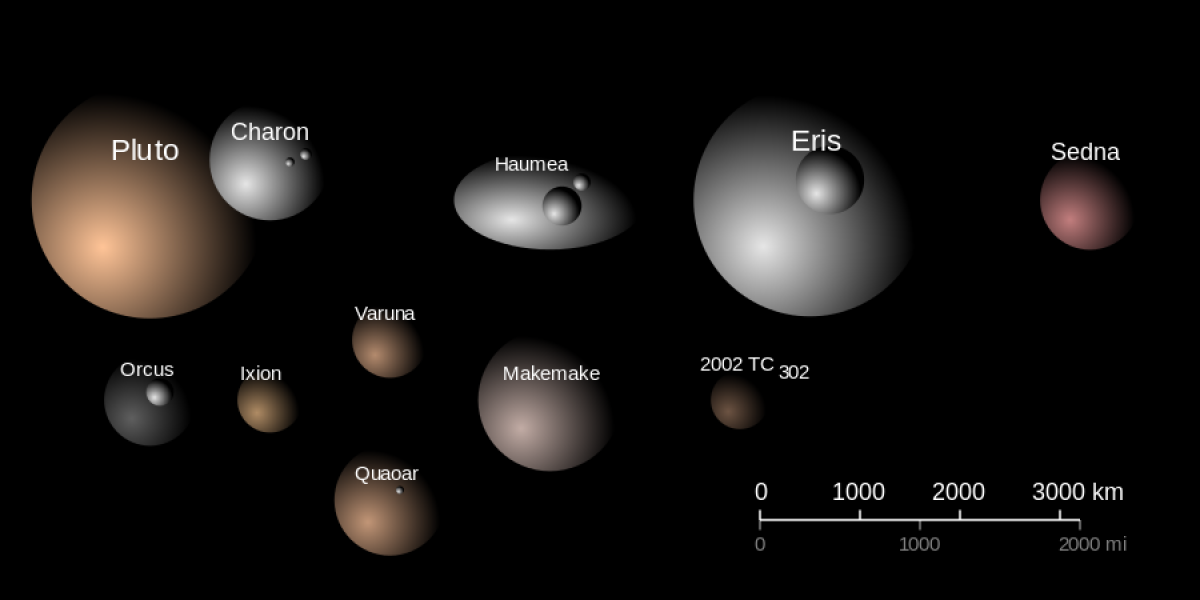
There are similarities between the 8 planets and the dwarf planets. All of them are rounded in shape. And they all orbit the Sun.
The discovery of Eris in 2005 led to a new category of Solar System object, called dwarf planets. Eris is a similar size to Pluto. Astronomers realised there were probably many more objects like Eris and Pluto out there.
This led to a lot of questions... should they all be planets? Should there be a new category? Should Pluto stay as a planet?
After a lot of discussion, the International Astronomical Union came up with a new definition of a planet. This led to Pluto being 'downgraded' to the dwarf planet category in 2006.
To be classed as a planet the object must:
- Orbit around the Sun.
- Be massive enough for its gravity to pull it into a rounded shape.
- Have cleared any smaller objects out of the area around its orbit.
| Facts and Figures | Ceres | Pluto | Haumea | Makemake | Eris |
|---|---|---|---|---|---|
| Orbital distance (AU) a | 2.77 | 39.5 | 43.1 | 45.8 | 67.7 |
| Orbital Inclination | 10.6° | 17.1° | 28.2° | 29° | 44° |
| Radius (km) | 487 | 1,137 | 1,436 | 750 | 1,300 |
| Mass (Earth Masses) b | 0.00016 | 0.00213 | 0.0007 | 0.0007 | 0.003 |
| Year Length (Earth Years) | 4.6 | 248.5 | 283.3 | 309.9 | 557 |
| Day Length (Earth Days) | 0.38 | 6.39 | 0.16 | Unknown | Unknown |
| Surface Gravity (g) c | 0.003 | 0.04 | 0.044 | 0.05 | 0.08 |
| Surface Temperature (approx.) | -105°C | -230°C | -240°C | -243°C | -240°C |
| Number of Moons | 0 | 3 | 2 | 0 | 1 |
| a 1 AU (or Astronomical Unit) = 149,600,000 km and is the mean distance from the Earth to the Sun b 1 Earth Mass = 5,980,000,000,000,000,000,000,000 kg c 1 g = 9.8 m/s2 | |||||
- The Kuiper Belt
The Kuiper Belt is a thick disk of icy rocks beyond the orbit of Neptune. The disk of material is roughly in line with the orbits of the planets in our Solar System. It's a bit like the asteroid belt but much larger. There are at least 100,000 icy and rocky objects in the Kuiper Belt. In fact, some moons of Saturn and Neptune are thought to have come from there.
Pluto and many of the other dwarf planets in our Solar System are part of the Kuiper belt. In 2015, the New Horizons mission became the first spacecraft to explore the Kuiper belt.
Image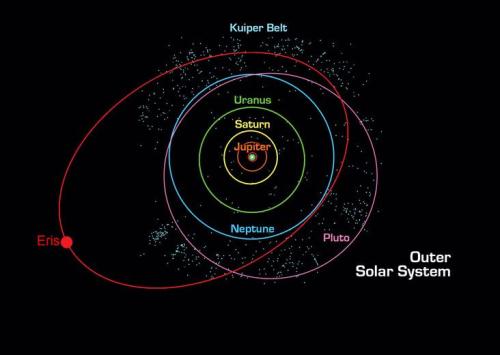 CreditThis work by NASA is licensed under Creative Commons Zero v1.0 Universal
CreditThis work by NASA is licensed under Creative Commons Zero v1.0 Universal- Ceres
Ceres is a dwarf planet between the orbits of Mars and Jupiter. It is also the largest object in the asteroid belt. Ceres was added to the dwarf planet category in 2006. Before then, it was called an asteroid.
The Italian astronomer, Giuseppe Piazzi discovered Ceres in 1801. Since then, astronomers have found 4 other dwarf planets. However, Ceres is still the only one in the inner Solar System. All the others are out past the planet Neptune.
Ceres is made of ice and rock. It is 930 km across which is about half the size of our own Moon. Ceres is so big it contains 25% of all the mass in the whole asteroid belt! But it is small for a dwarf planet. Pluto is 14 times more massive than Ceres. Ceres takes 4.6 Earth years to orbit the Sun. It rotates every 9 hours.
The Dawn spacecraft studied Ceres from 2015 to 2018. During that time, Dawn was in orbit around Ceres and made a map of its surface. The rocky surface is dusty and has lots of craters and large areas of salt. Though it is not the same as salt you would put on your chips (sodium chloride)! It's made from other minerals. Dawn also discovered that Ceres has ice volcanoes! These are volcanoes which release icy liquids, instead of hot lava.
- Eris
Eris is a dwarf planet. It is part of the Kuiper Belt in the outer reaches of the Solar System. Eris is about 68 astronomical units from the Sun. It takes light from the Sun more than 9 hours to reach Eris!
Eris was first seen in 2005. Its discovery caused a debate amongst astronomers about whether this new object would be a planet. The discussion led to a new category of objects, called dwarf planets. The former planet Pluto was included as a dwarf planet.
Eris is one of the biggest dwarf planets. It's about the same size as Pluto but is 3 times further from the Sun than Pluto. Like Pluto, it's about three-quarters the size of our Moon. We think Eris is made of ice and rock. It's so cold that Eris' atmosphere often freezes and falls as snow.
Eris orbits the Sun every 558 years. Like other dwarf planets, its orbit is very elliptical and is tilted compared to the 8 planets. As Eris orbits the Sun, it rotates on its axis. It takes 25.9 hours to spin around once, similar to Earth! Eris has one small moon of its own, called Dysnomia. Dysnomia is only around 150 km across and orbits Eris every 15.8 days.
Image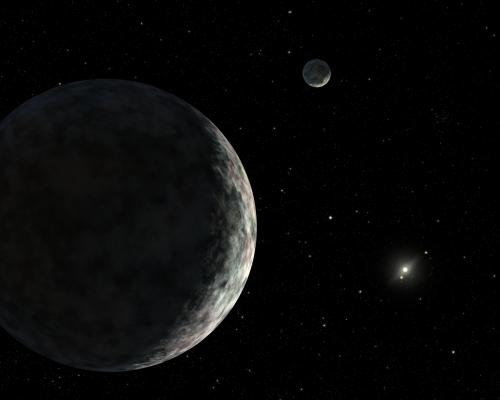 CreditThis work by NASA/JPL-Caltech is licensed under Creative Commons Zero v1.0 Universal
CreditThis work by NASA/JPL-Caltech is licensed under Creative Commons Zero v1.0 UniversalArtist's impression of Eris and it's moon - Haumea
Haumea (pronounced how-may-a) is a dwarf planet. It was discovered in 2004 and officially became a dwarf planet in 2008. Haumea completes one orbit of the Sun every 283 Earth years.
Haumea is part of the Kuiper Belt. It orbits the Sun from a distance of about 43 astronomical units (AU). However, it is sometimes as close as 35 AU or as far out as 52 AU. This is because its orbit has a very elliptical shape.
We have not yet been able to look at Haumea in any detail. This is because it is too far away and too small to be clearly seen using a telescope on Earth. Also, spacecraft have not visited it yet. However, astronomers think it looks like a rugby ball. They worked this out by observing the way it reflects light. Haumea has this unusual shape because it is one of the fastest rotating objects in our Solar System. It spins once every 4 hours!
Like Makemake, Haumea is smaller than Eris or Pluto. Its longest side is about 2000 km in size. The shorter side is about 1000 km. Haumea contains about one-quarter of their mass of Pluto. Haumea is made of rock covered in ice. It is very cold because it is so far from the Sun. The average surface temperature is thought to be around -240 °C (or 32 K).
Haumea has two known moons, named Hiʻiaka and Namaka. It is also the first known object in the Kuiper Belt to have rings.
Video fileCreditThis work by Stephanie Hoove is licensed under Creative Commons Zero v1.0 UniversalImage of Ceres taken with the Dawn spacecraft - Makemake
Makemake (pronounced Mah-keh Mah-keh) is a dwarf planet. It was discovered in 2005 and was officially named a dwarf planet in 2008.
Makemake is part of the Kuiper Belt. It takes about 305 Earth years to make one orbit of the Sun. It orbits the Sun from a distance of about 46 astronomical units (AU), way beyond Neptune. However, it is sometimes as close as 39 AU or as far out as 53 AU. This is because its orbit has an elliptical shape. If we sent a spacecraft to Makemake, it would take at least 16 years to get there!
Like Haumea, Makemake is smaller than the dwarf planets, Eris and Pluto. It has a radius of about 400 km. This means you could fit about 20 Makemake-sized objects side-by-side across the diameter of the Earth. Despite its small size, Makemake is the second brightest object in the Kuiper Belt.
Makemake is made of rock and ice. Observations suggest it is very cold. It has an average temperature of around -243°C (or 30K). Its surface is a red-brown colour, similar to Pluto.
In 2016, the Hubble Space Telescope spotted a small moon orbiting Makemake. The moon does not have an official name yet.
Image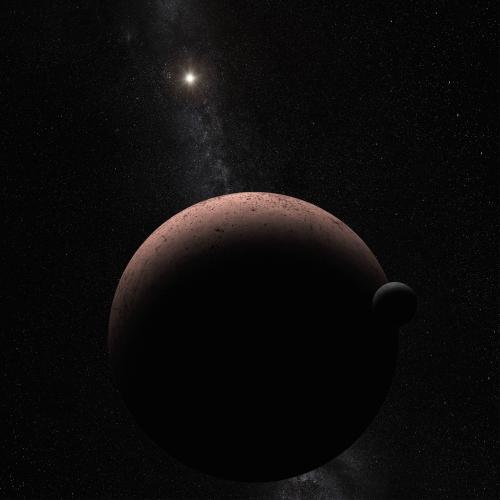 CreditThis work by NASA, ESA, A. Parker and M. Buie (Southwest Research Institute), W. Grundy (Lowell Observatory), and K. Noll (NASA GSFC) is licensed under Creative Commons Zero v1.0 Universal
CreditThis work by NASA, ESA, A. Parker and M. Buie (Southwest Research Institute), W. Grundy (Lowell Observatory), and K. Noll (NASA GSFC) is licensed under Creative Commons Zero v1.0 UniversalAn artist's impression of Makemake - Pluto
- Image
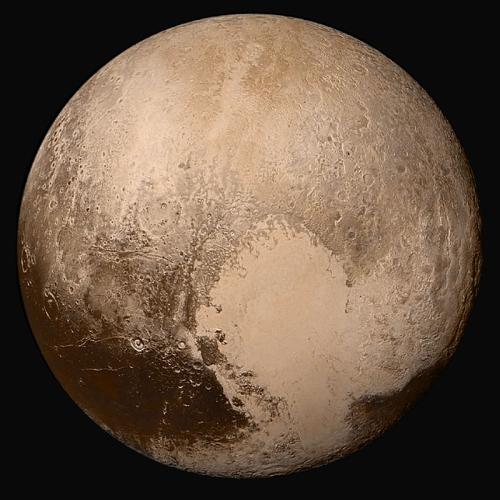 CreditThis work by NASA New Horizons is licensed under Creative Commons Zero v1.0 Universal
CreditThis work by NASA New Horizons is licensed under Creative Commons Zero v1.0 UniversalPluto up close Pluto is a dwarf planet in the Kuiper Belt. Clyde Tombaugh discovered it in 1930. For over 70 years, Pluto was the 9th planet of our Solar System. In 2006, the International Astronomical Union decided Pluto should be in the new dwarf planet category. This category was created because astronomers had discovered 3 other objects which were a similar size to Pluto (Eris, Haumea, and Makemake). These 3 dwarf planets and Pluto are also known as Plutoids.
Pluto takes 248 Earth years to orbit the Sun. Its orbit is very elliptical. This means it takes a stretched-out, oval path, rather than a circular one, around the Sun. Pluto's orbit is also inclined to the orbits of the planets by about 17°.
On average, Pluto is 93 astronomical units from the Sun. It takes light from the Sun 5 and a half hours to reach Pluto. One day on Pluto takes about 153 hours and Pluto spins backwards, like Venus and Uranus. This means the Sun rises in the west, rather than the east. Though because Pluto is so far from the Sun, the light is much dimmer than on Earth.
Pluto is about 2500 km wide, which is three-quarters the size of Earth's Moon. It probably has a rocky core in its centre, surrounded by layers of ice.
We know quite a lot about Pluto because the New Horizons space probe studied it for 6 months in 2015. Mountains, valleys, plains and craters cover its ice surface. The tallest mountain on Pluto is about 3 km high. This is bigger than the tallest mountain in the UK! Pluto also has a thin atmosphere made mainly of nitrogen.
Pluto has a very low temperature, which can drop to - 240 °C. It often gets cold enough for the atmosphere to freeze and fall as snow, but the snow is red! Pluto also has a heart-shaped glacier on its surface. This is named the Tombaugh Regio after the person who discovered Pluto.
Astronomers have found 5 moons in orbit around Pluto. The largest, Charon, is around half the size of Pluto. The others (Hydra, Nix, Kerberos, and Styx) are much smaller.
Image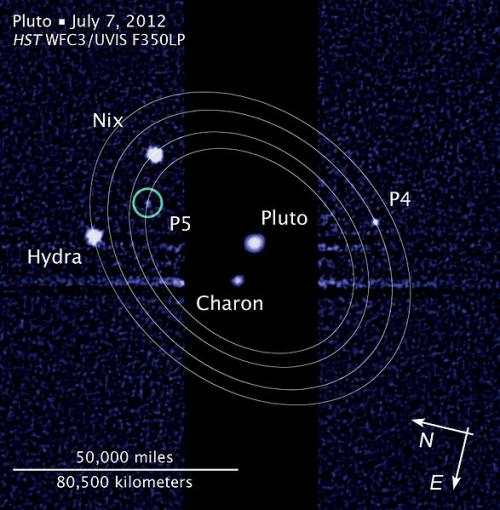 CreditThis work by NASA/ESA/Frattare is licensed under Creative Commons Zero v1.0 Universal
CreditThis work by NASA/ESA/Frattare is licensed under Creative Commons Zero v1.0 UniversalPluto and its moons. P4 is Kerberos, P5 is Styx.
